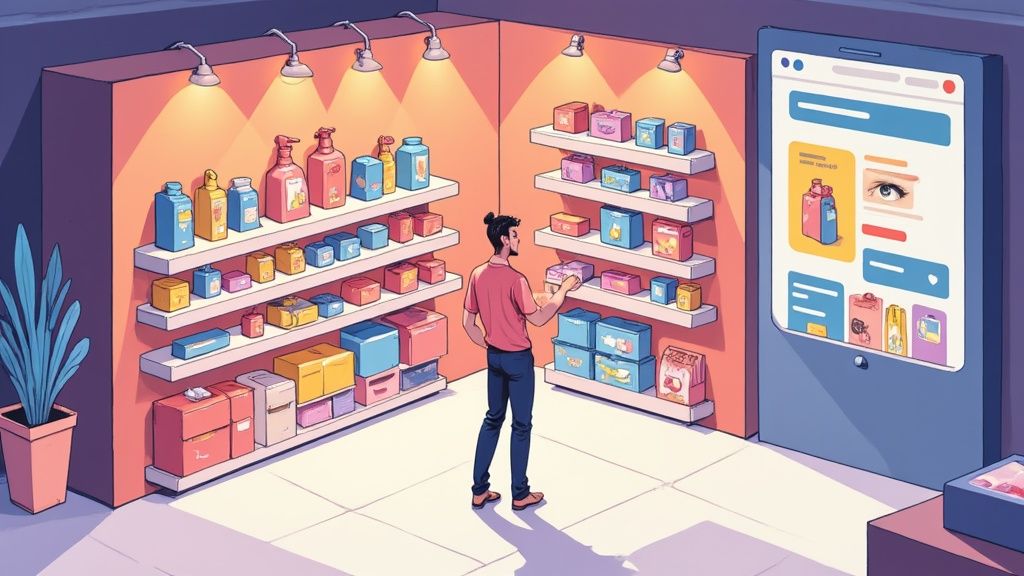Ever heard of a "silent salesperson"? That’s the perfect way to think about visual merchandising. It’s the strategic art of presenting your products in a way that attracts, engages, and ultimately convinces customers to make a purchase.
It uses everything from your storefront window to your in-store layout to tell a compelling brand story and make the shopping experience feel effortless.
Understanding Visual Merchandising: Your Silent Salesperson
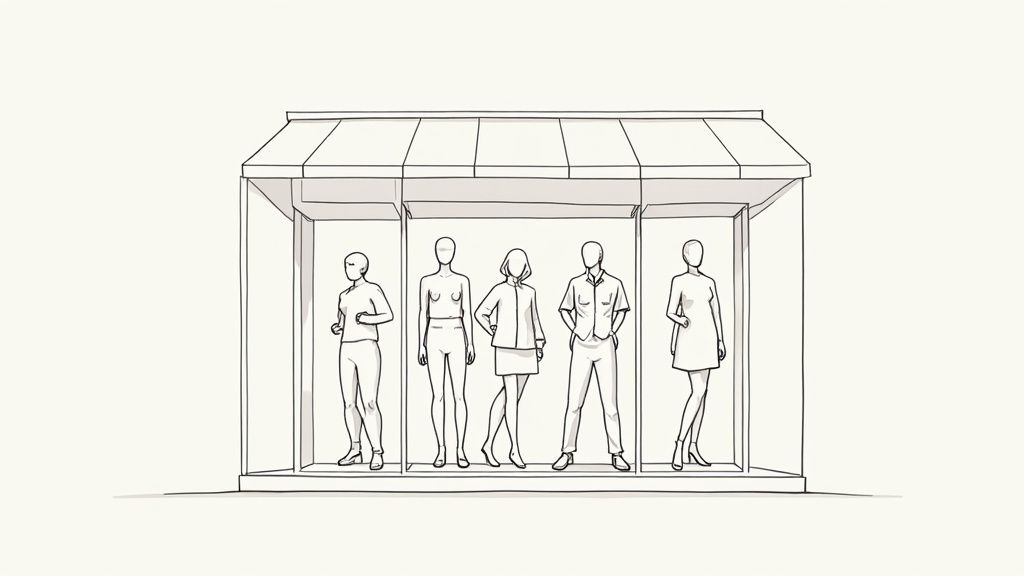
Picture this: you’re walking down the street and pass two clothing stores. The first is a chaotic jumble of overflowing racks and dim, uninviting lighting. The second is bright, clean, and has a stunning window display that grabs your attention instantly.
Which one are you more likely to step into? Almost everyone would pick the second one, and that’s the power of visual merchandising in action.
It's the invisible force that shapes how a customer feels about your brand from the moment they see it. In fact, a shopper decides whether they’ll stay or leave within the first few seconds of entering a retail space. That snap judgment isn't based on your prices or even your products—it’s based on the atmosphere you’ve created.
Great merchandising turns a simple store into an immersive experience.
It's More Than Just Making Things Look Pretty
While aesthetics are a huge part of it, the real goal of visual merchandising is much more strategic. It's a calculated practice that blends pure creativity with hard commercial goals.
Every single decision—from the color of a backdrop to the precise placement of a mannequin—is made to influence customer behavior and, of course, drive sales. It’s all about creating a journey for the shopper, guiding their eyes to key products, and making the path to the checkout counter as smooth and enjoyable as possible.
A great window display can forge an emotional connection so strong that customers feel they have to come inside. Once they're in, great merchandising makes them feel like they can't go home without buying something.
This approach is a critical business function, not just a creative afterthought. A well-executed strategy brings together several key goals to build a cohesive and profitable experience.
To put it simply, here’s a quick breakdown of what visual merchandising sets out to achieve.
Core Objectives of Visual Merchandising
| Objective | Description | Key Benefit |
|---|---|---|
| Attract Customers | Use compelling window displays and store entrances to draw foot traffic and create a strong first impression. | Increases store traffic and brand visibility. |
| Engage Shoppers | Create an immersive, easy-to-navigate environment that encourages exploration and interaction with products. | Boosts customer dwell time and product discovery. |
| Tell a Story | Communicate your brand's identity, values, and seasonal themes through cohesive visual elements. | Builds brand loyalty and emotional connection. |
| Drive Sales | Strategically highlight bestsellers, new arrivals, or high-margin items to guide purchasing decisions. | Increases average transaction value and overall revenue. |
Ultimately, understanding what visual merchandising is means seeing it for what it truly is: a powerful investment in your brand’s perception, your customer’s loyalty, and your bottom line.
The Core Elements of Effective Visual Merchandising
To really get what visual merchandising is all about, we need to break it down. Think of a visual merchandiser as a movie director. Every single element—the color palette, the lighting, the placement of props—is a deliberate choice designed to create a specific mood, guide the audience, and tell a compelling story. Mastering these core components is how you turn a simple retail space into a powerhouse that sells.
These elements all have to work together, but each one plays its own critical role in shaping how a customer feels and acts. From the moment someone walks past your window to the final tap of their credit card, these components are working behind the scenes to guide their journey.
Color and Lighting: The Atmosphere Creators
Color is probably the most powerful, unspoken tool a retailer has. It triggers emotions in an instant. Warm colors like red and orange can spark a sense of urgency, which is why you see them plastered all over sale sections. On the other hand, cool colors like blue and green create feelings of calm and trust, making them a go-to for high-end or wellness brands. Fun fact: while people often say they love bright colors, research shows they overwhelmingly buy items in black, gray, and white. This makes neutral tones a super safe and effective foundation for any display.
Lighting is color's partner in crime. It does way more than just help people see—it directs their focus and sets the entire mood of the space.
- Accent Lighting: This is your spotlight. Use it to highlight key products or displays, creating a dramatic focal point that pulls the customer's eye right where you want it. Imagine a single, bright light on a mannequin rocking a new-season coat.
- Ambient Lighting: This is the general lighting for the whole store. It needs to be bright enough to be comfortable but should match your brand’s vibe. A luxury boutique might go for softer, warmer light, while a bustling tech store will probably be brighter and cooler.
Store Layout and Flow: The Shopper's Journey
An intuitive store layout is the roadmap you create for your customer. A bad one leads to pure frustration and lost sales. A good one? It guides shoppers effortlessly past your most important products. One of the most common and effective layouts is the circular path, which creates a clear walkway that encourages customers to see the entire store.
The goal is simple: no dead ends, no confusing aisles. Every square foot of your floor space needs a purpose. This includes everything from the high-traffic "power wall" (usually just to the right of the entrance) to the clever placement of impulse-buy items right by the checkout counter.
A well-designed layout, often called a planogram, is basically a detailed blueprint. It maps out the entire use of space and dictates exactly where every single piece of merchandise goes to maximize exposure and create a logical shopping flow.
Signage and Storytelling: The Brand's Voice
Signage is your in-store narrator. It needs to be clear, to the point, and a perfect match for your brand's voice and style. Great signage answers questions before customers even think to ask, giving them info on pricing, promos, and product benefits without creating a ton of visual clutter.
Storytelling is what ties all these other elements together into one cohesive theme. It’s the narrative that connects your window display, in-store promotions, and how you group your products. Whether you're going for a "Summer Getaway" collection or a "Cozy Winter" vibe, a strong story makes the shopping experience stick in a customer’s mind and connect on an emotional level. This is especially true online, where fantastic visuals are everything. For e-commerce brands, using professional product photo editing services is non-negotiable for telling a consistent and compelling story across every single digital touchpoint.
Why Great Visual Merchandising Drives Retail Growth
Let's be clear: effective visual merchandising isn't just about making your store look pretty. It's a powerful engine for business growth, bridging the gap between a beautifully designed space and real, tangible financial results. Think of it as a crucial investment in your brand's profitability—a direct line to higher revenue.
Why? Because great merchandising transforms casual browsers into committed buyers. It elevates the shopping experience from a simple transaction into a memorable interaction with your brand, encouraging customers to stick around longer and, ultimately, spend more money. The impact on your bottom line isn't just a theory; it's a measurable outcome.
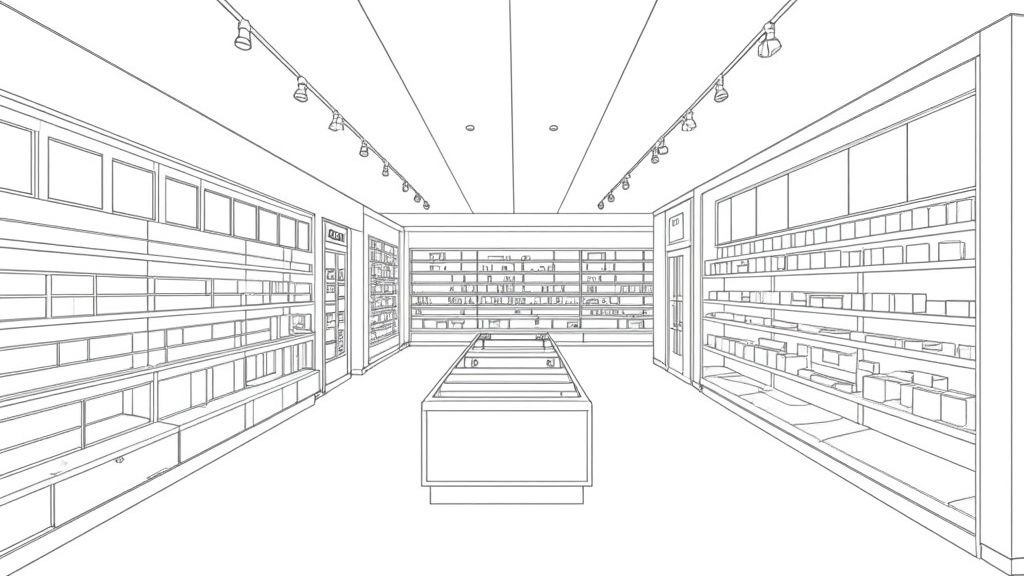
On the flip side, a poor visual strategy doesn't just fail to inspire—it actively drives customers away. A confusing layout, cluttered shelves, or uninspired displays create frustration and can make your products feel cheap. This negative experience doesn't just hurt sales in the moment; it can permanently damage your brand's reputation.
The Financial Impact of Merchandising Done Right
The connection between how a store looks and how much it sells is incredibly strong. When customers feel comfortable and engaged, they are statistically far more likely to make a purchase. An organized, visually appealing environment smooths out the shopping journey, making it easier for them to find what they're looking for and discover new items they didn't even know they wanted.
The cost of getting it wrong is staggering. Visual merchandising directly influences consumer behavior, and dropping the ball leads to significant financial losses. A recent U.S. study revealed that almost 50% of consumers walked out of at least one store in the past year simply because they were unhappy with its visual quality. This behavior adds up to an estimated $125 billion annual loss for the U.S. retail sector alone. You can dig into the full research on these retail trends to get deeper insights into shopper behavior.
This proves that investing in visual merchandising isn't an expense. It's a critical business strategy for winning and keeping customers.
Key Growth Drivers of Strong Visuals
A thoughtful merchandising plan delivers results across several key areas of your business. It’s a multi-faceted tool that boosts performance from the front window all the way to the checkout counter.
The highest goal a store can achieve with an amazing window display is to create an emotional connection with customers so strong that they must come inside. Great merchandising makes them feel that once they are inside, they can't go home without buying something.
This connection is built by focusing on specific, tangible benefits:
- Increased Foot Traffic: A captivating window display is your best advertisement. It turns passersby into potential customers by sparking curiosity and creating a powerful first impression.
- Higher Conversion Rates: An intuitive store layout and clear product storytelling guide shoppers seamlessly toward a purchase, dramatically reducing the chance they leave empty-handed.
- Boosted Customer Loyalty: A consistently positive and engaging in-store experience builds a real emotional bond with your brand. This encourages repeat visits and fosters the kind of long-term loyalty that every business needs.
Applying Merchandising Principles to Your Digital Storefront
In the world of e-commerce, your website is your flagship store. Your digital storefront. Just because there are no physical walls doesn't mean the principles of visual merchandising disappear—they just get a digital makeover.
Think about it: every single element, from your homepage layout to your product descriptions, works together. They combine to create a shopping experience that can either pull a customer in or push them away for good.
Your homepage is your storefront window. It's that critical first impression that has to stop a scroller in their tracks and make them want to come inside. Just like a physical display, it needs to be captivating, tell a clear story, and instantly show what your brand is all about. This is your chance to feature bestsellers, new arrivals, or a killer promotion to create an instant hook.
Translating Physical Space to Digital Pixels
The strategic layout of a physical store translates directly to your website's navigation and overall user experience. An intuitive menu, logical category pages, and a checkout process without any hiccups—these are the digital versions of a well-designed floor plan. The goal is simple: guide visitors from "just looking" to "just bought" without any friction or confusion.
High-quality visuals are your most powerful tool in this digital space. Crisp, clean product photos are completely non-negotiable; they're your primary display. To really elevate the experience, investing in professional Shopify product photography helps create that consistent, high-end look that builds trust and makes your products feel more tangible to someone shopping through a screen.
The chart below shows just how much different merchandising tactics can impact the bottom line.
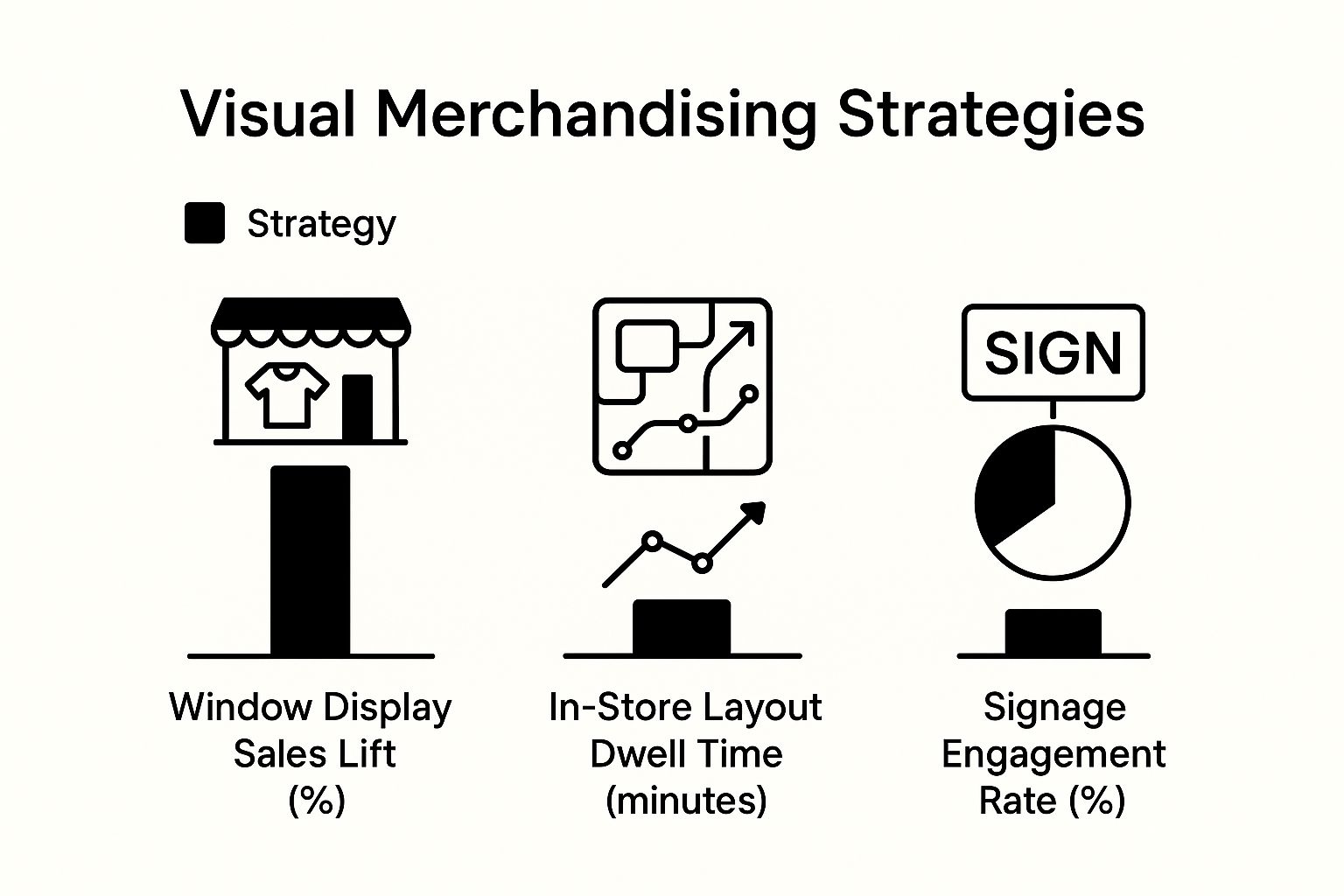
As the data shows, a well-executed window display can deliver the biggest immediate sales lift. This really drives home the power of a strong first impression, whether it’s on a busy street or a busy browser tab.
While we're talking about translating tactics from the real world to the web, it's helpful to see a side-by-side comparison of how these core ideas adapt.
Comparing Physical and Digital Merchandising Techniques
| Principle | In a Physical Store | On an E-commerce Site |
|---|---|---|
| Storefront Window | An eye-catching display with mannequins, props, and key products to draw people in. | The homepage "hero" banner, featuring new collections, promotions, or brand storytelling. |
| Store Layout | A planned path that guides customers past high-value items, with clear aisles and signage. | An intuitive navigation menu, logical product categories, and breadcrumbs to prevent users from getting lost. |
| Product Displays | Products grouped by theme, color, or use on tables, shelves, and racks. | Curated collection pages, "Shop the Look" features, and product recommendation carousels. |
| Signage | Signs that announce sales, provide product info, or guide customers to different departments. | Banners, pop-ups, and clear "call-to-action" buttons that guide the user's next step. |
| Lighting & Ambiance | Strategic lighting to highlight products and create a mood (e.g., bright and energetic vs. warm and cozy). | Website color palette, font choices, and the overall design aesthetic that reflects the brand's personality. |
This table shows that while the tools change, the fundamental goal of guiding the customer and creating an appealing environment remains exactly the same.
Creating Immersive Digital Experiences
Beyond static images, storytelling through lifestyle photography and video is where the magic happens. These elements help customers truly envision the products in their own lives. They answer unasked questions about size, fit, and feel. A sweater just looks better on a person than on a white background, and a piece of furniture feels more real in a styled room.
An effective digital storefront doesn't just list products; it curates experiences. It groups items into compelling collections, tells stories through blog posts, and uses user-generated content to build a sense of community and authenticity.
A really powerful way to turn passive viewers into active buyers is by using interactive shoppable video strategies. These allow customers to buy products directly from the video they're watching. This seamless blend of entertainment and commerce is a perfect example of modern digital merchandising at its best.
Ultimately, applying visual merchandising online means being just as intentional with your digital space as you would be with a physical one. It’s all about creating a cohesive, visually stunning, and user-friendly environment that not only shows off your products but also reinforces your brand identity and, most importantly, drives sales.
The Future of Visual Merchandising and Retail Innovation
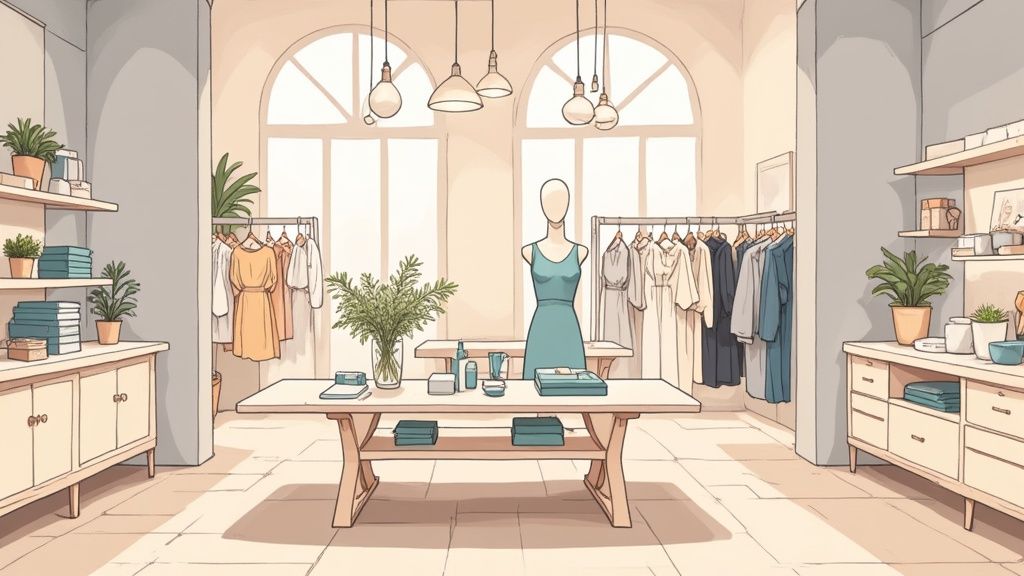
The world of retail never stands still, and visual merchandising is evolving right alongside it. The future isn't just about arranging products nicely on a shelf; it's about building intelligent, responsive, and deeply personal shopping environments. Technology is the main driver here, turning static displays into dynamic, interactive experiences that blur the lines between the physical and digital worlds.
This shift is happening for one simple reason: today's customers expect more. They want personalization, immersion, and a smooth journey, whether they're in a store or browsing online. This means visual merchandising is evolving from a silent salesperson into an active, data-savvy guide for every single customer.
The Rise of Smart and Interactive Spaces
One of the biggest changes we're seeing is digital tech being woven directly into the store floor. Smart displays and interactive screens are taking the place of traditional posters and mannequins, creating a far more engaging and personalized path to purchase.
Imagine walking past a digital sign that instantly updates its content based on your loyalty app data or the items you were just looking at online. This isn't science fiction anymore; it's fast becoming reality. These advancements are making merchandising more interactive and even more sustainable. Digital signs can adapt in real-time, gamified kiosks can offer fun incentives, and retailers are increasingly choosing eco-friendly materials for their physical setups.
Of course, this all needs to feel connected. A great experience has to be consistent across every channel. For a deeper look at tying it all together, it's worth exploring effective omnichannel marketing strategies.
Personalization Through Augmented Reality
Augmented Reality (AR) is another game-changer that’s completely reshaping how customers connect with products before buying. This tech lets shoppers use their smartphones to see how a new sofa would look in their living room or how a pair of sunglasses might fit their face, all without leaving the store or their home.
By taking the guesswork out of buying, AR technology gives shoppers a massive confidence boost and seriously cuts down on returns. It's an incredibly powerful tool for both online and brick-and-mortar retailers.
This creates a "try before you buy" experience that was once impossible. It also lives in the digital world, where tools like an AI product photo generator can produce stunning, hyper-realistic images that help customers visualize products in all sorts of different settings.
This tech-forward approach delivers a few key wins:
- Enhanced Customer Engagement: Interactive elements make shopping more fun and memorable.
- Data-Driven Decisions: Retailers can use interaction data to optimize store layouts and displays on the fly.
- Reduced Purchase Friction: AR helps customers feel sure about their decisions, and they make them faster.
Ultimately, the future of visual merchandising is all about creating smarter, more sustainable, and deeply personalized experiences. It’s a dynamic blend of art, technology, and data that makes shopping more intuitive and rewarding for everyone involved.
Got Questions About Visual Merchandising? Let's Talk.
Once you start digging into visual merchandising, a lot of questions pop up. It's one thing to understand the theory, but another thing entirely to make it work in your own store. I get it. This is where we bridge that gap.
I’ve pulled together some of the most common questions I hear from retailers. Think of this as a practical, no-fluff guide to help you sidestep the usual pitfalls and get things right from the start.
How Often Should I Change My Displays?
This is a big one. For your most important displays—think your main window and the first thing people see when they walk in—aim for a refresh every four to six weeks. This rhythm keeps your store from feeling stale and lets you sync up with seasons, holidays, or new product drops.
That regular changeup is what keeps your regulars coming back; they're genuinely curious to see what you've done with the place.
For smaller displays and focal points scattered around the store, you can move a lot faster. Try switching these up weekly or bi-weekly. It’s a great way to shine a light on new arrivals, feature a bestseller, or give a little push to slow-moving items. These small, constant tweaks create a dynamic shopping experience without needing a massive overhaul every month.
What Is the Biggest Mistake to Avoid?
Easy. The single biggest mistake I see, time and time again, is clutter. It’s so tempting to cram every last product you have onto the floor, but it completely backfires. When shelves and tables are overflowing, customers get overwhelmed. Nothing stands out because everything is screaming for attention.
A cluttered store doesn't just look messy; it feels stressful. It subconsciously devalues your products and your brand, signaling disorganization. More often than not, shoppers get anxious and just walk right back out. Your goal is to make browsing feel easy and inspiring, not like digging through a messy closet.
The best merchandising is always clean, organized, and focused. Every display should tell one clear story, giving your products room to breathe so shoppers can actually see and appreciate them.
Can Small Businesses Actually Use Visual Merchandising?
Absolutely. There's a huge misconception that you need a Hollywood-sized budget to do this well. The truth? Creativity and strategy will always beat a big budget. Small businesses can get amazing results by nailing the fundamentals, most of which don't cost a dime.
Start with these game-changers:
- Lighting: Make sure your store is bright and inviting. Even a few cheap spotlights can create dramatic focal points on your hero products. Good light just makes everything look more professional.
- Color and Organization: Group products by color. It’s an incredibly simple trick that creates instant visual harmony. Keep things tidy and create clear paths for people to walk through.
- Storytelling: Use your products to tell a little story. You don’t need fancy props. A simple, well-placed sign and a thoughtful arrangement of products can communicate a powerful theme.
Thoughtful planning and consistency are free, and their impact is massive. A clean, organized, and cohesive space will always outperform an expensive but chaotic one. It’s all about being smart with what you’ve got.
Ready to transform your own product photos into stunning, professional images that sell? With ProdShot, you can turn simple smartphone pictures into high-quality, conversion-ready visuals in seconds. Elevate your online store today at https://prodshot.net.

